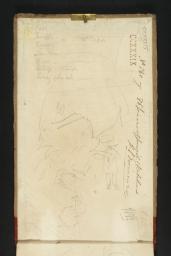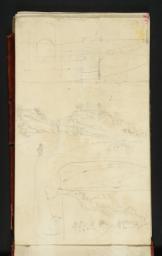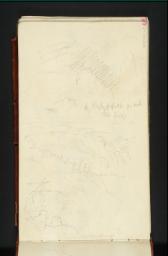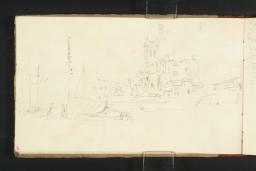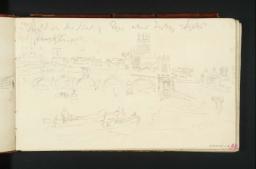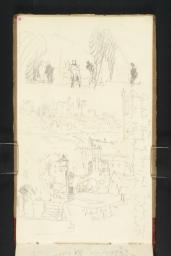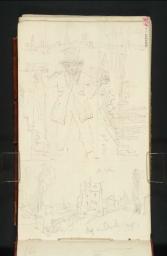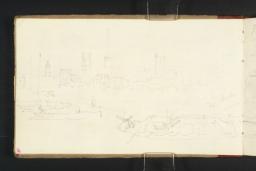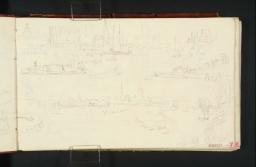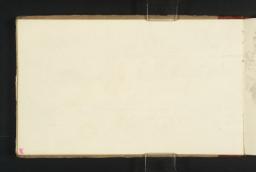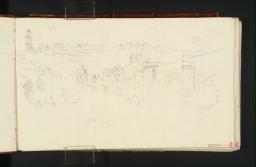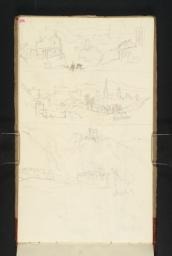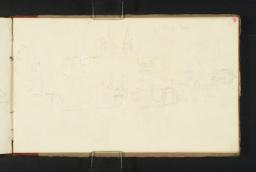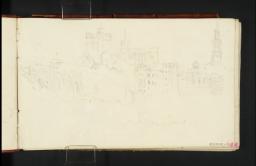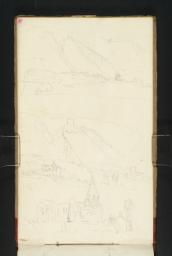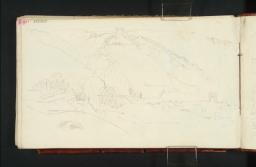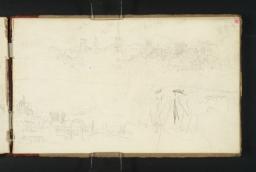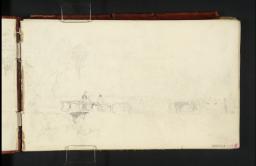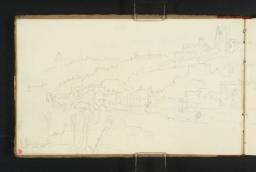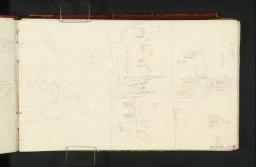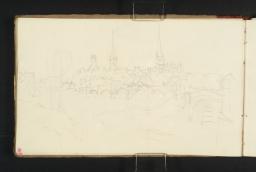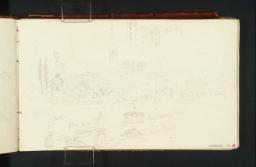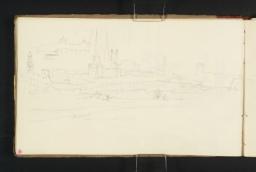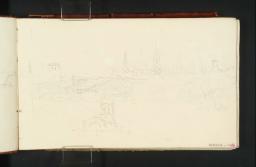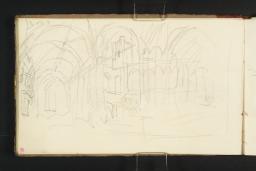Turner Bequest CCXI 42, 42a, CCXXXIX 1–91a
Sketchbook bound in boards, quarter bound in buff paper with brown leather spine and a brass clasp; leather pencil loop along top edge of back cover, inset between paper cover and pastedown
92 leaves and pastedowns of white wove paper, with edges washed yellow; various sheets watermarked ‘R Barnard | 1820’; page size 114 x 191 mm
Made by Richard Barnard of Eyehorn Mill, Kent
Numbered 360 as part of the Turner Schedule in 1854 and endorsed by the Executors of the Turner Bequest inside front cover (D41053)
Blind-stamped with Turner Bequest monogram on leather part of front cover, towards top left
Inscribed in pencil ‘CCXXXIX’ towards top left
Stamped in black ‘CCXXXIX’ top right
92 leaves and pastedowns of white wove paper, with edges washed yellow; various sheets watermarked ‘R Barnard | 1820’; page size 114 x 191 mm
Made by Richard Barnard of Eyehorn Mill, Kent
Numbered 360 as part of the Turner Schedule in 1854 and endorsed by the Executors of the Turner Bequest inside front cover (D41053)
Blind-stamped with Turner Bequest monogram on leather part of front cover, towards top left
Inscribed in pencil ‘CCXXXIX’ towards top left
Stamped in black ‘CCXXXIX’ top right
Accepted by the nation as part of the Turner Bequest 1856
Exhibition history
References
The subjects in this sketchbook, noted by A.J. Finberg as primarily ‘Worcester, Bridgenorth [sic, i.e. Bridgnorth], Shrewsbury, Chester, Haddon Hall, Castleton, and [the Peak District west of] Chesterfield’,1 were assumed by him to have been recorded in the course of a single tour of the English Midlands, probably begun in late August 1830 and concluded before 1 November, when Turner used the Kenilworth and Birmingham and Coventry sketchbooks (Tate; Turner Bequest CCXXXVIII, CCXL respectively), as sequenced in Finberg’s 1909 Turner Bequest Inventory2 either side of the present book. Later scholars have followed Finberg in grouping the three books together in 1830, noting that Turner was in search of new material for England and Wales compositions,3 to compensate for the relative lack of Midlands source material since the 1790s; see in particular Wilton’s ‘Midlands 1794–1802’ section in the present catalogue.
However, the present author’s ‘Midlands 1830’ section of this catalogue comprises only the interlinked Kenilworth and Birmingham and Coventry sketchbooks (Tate; Turner Bequest CCXXXVIII, CCXL), which record a quite separate itinerary further south. In preliminary discussions with fellow cataloguer Thomas Ardill,4 based on advice and unpublished notes by Tate colleague Ian Warrell,5 a link was established between the Worcester and Shrewsbury book and Turner’s journey to Scotland in 1831, although for clarity it was agreed to present the sketchbook as a discrete unit. The unusually precise documentation of Turner’s movements in the summer of 1831 is largely in terms of the main Scottish tour, as Ardill has set out comprehensively in the Introduction to the ‘Scotland 1831’ section. The itinerary and dates can be summarised as follows: Turner was approached early that year by the Edinburgh publisher Robert Cadell to make a series of watercolours for engraving illustrating Sir Walter Scott’s Poetical Works; he left London for Scotland after a Royal Academy meeting of 18 July, and sketched at Liverpool before reaching Manchester by 22 July, from where he travelled to Scott-related sites in northern England and southern Scotland before reaching Abbotsford, the author’s home, on 4 August; after an intensive two months around Scotland he was at Edinburgh on 17 September, probably leaving by sea the next day, and was back in London by 23 September.
As its name suggests, one strand of subjects in this Worcester and Shrewsbury sketchbook fits well with the Liverpool end of the route described: views of Worcester, probably the first site recorded here (see under folio 2 verso; D22154), Bridgnorth (see under folio 1 recto; D22151) and Shrewsbury (see under folio 12 verso; D22172), moving north-west up the River Severn, working inwards from both ends of the book. Overlapping slightly with the Shrewsbury sequence at the back as now foliated is the main run of Chester views, and there are also a few Chester sketches after those of Shrewsbury at the front (see under folio 14 verso; D22176). Chester is north of Shrewsbury, and the next major destination northwards in turn is Liverpool, and although there are no readily identifiable views of the latter in the present book, there are a few certainly or possibly showing nearby Manchester (see under folio 12 recto; D22171), which Turner is not known to have visited otherwise. Some of these views are tentatively proposed here as showing the new Liverpool and Manchester Railway (see under folio 16 recto; D22179). There are also views of Newcastle (see under folio 8 recto; D22163), where the artist could have stopped off as he returned from Edinburgh in September.
At the core of the book, between these sequences, are studies made in the Picturesque setting of the Derbyshire Peak District,6 divided about equally in number between views around Peveril Castle, the village of Castleton and the Peak Cavern (see under folio 1 verso; D22152), and a range of other sites in a concentrated area between Chapel-en-le-Frith, Buxton, Bakewell and Hathersage. There is a sketch map of this very area on folio 21 recto (D22187), under which Turner’s subjects in the locality, including Chatsworth, are noted. In undated manuscript notes in a copy of his 1909 Inventory, Finberg observed ‘Hathersage is where Holworthy lived’;7 in his subsequent Life of Turner, he assumed that the artist had used this sketchbook around Castleton on the summer 1830 tour of the Midlands, albeit quoting Turner’s letter of 7 November that year to his artist friend James Holworthy (1781–1841) at Brookfield Manor, Hathersage: ‘I could not get as far north as your worship’s residence.’8 This would appear rather disingenuous had the artist been so close in 1830,9 but the most northerly identified subject sketched that year, Ashby-de-la-Zouch, Leicestershire, lies just outside Derbyshire, some forty miles south of Hathersage, making his excuse for being ‘delinquent with [Holworthy’s] invitations’10 understandable on that occasion.
As Ian Warrell has noted,11 the presence of so many views of Peveril Castle implies an intention to illustrate a new edition of Scott’s novel Peveril of the Peak (first published in 1823), although nothing came of this. Haddon Hall is another Derbyshire site associated with the story (see under folio 24 recto; D22192). These subjects imply a date of 1831 or later given Turner’s renewed involvement with Scott at that time, but the immediate difficulty lies in the timing of the journeys north and south framing the 1831 Scottish tour, with less than a week to account for at each end between Turner’s documented presence in London and Manchester, and later Edinburgh and London. The Worcester-Chester sequence seems feasible on the way north, but the rather rambling Derbyshire itinerary would seem to have required more time. Turner would have had to travel there overland from Newcastle, perhaps picking up the Great North Road as far as Sheffield, before conducting his Peak District tour and going on south to London. Instead, he probably travelled to the Peak later in 1831 or a short time afterwards while the Scott project was still current, took this sketchbook with him to make use of the remaining pages, and perhaps stayed with or near his good friend Holworthy at leisure.
Warrell has suggested an overall date of ‘?1831–2’ for the sketchbook,12 but in the absence of more precise documentary evidence and the convoluted physical overlapping of Severn and Peak drawings, all works have been dated to ‘?1831’, for the present, indicating that the date is likely but unconfirmed. As Warrell has observed, drawings of the well advanced but incomplete Grosvenor Bridge, Chester, under construction between 1827 and 1833 (see under folio 14 verso; D22176) are further indications of a date early in the 1830s.13
The only finished subject Turner developed from the present material is the watercolour Worcester of about 1834 (British Museum, London),14 engraved for the Picturesque Views in England and Wales series in 1835 (Tate impression: T06117), and derived in particular from folios 81 verso and 83 verso (D22300, D22304; Turner Bequest CCXXXIX 80a, 82a). In the event, later editions of Scott’s ‘Waverley Novels’ were to include other artists’ somewhat Turnerian images of Peveril Castle and Haddon Hall. Tate Britain’s Prints and Drawings Room holds an 1848 set (Robert Cadell, Edinburgh) with illustrations as follows: Peak Castle, Castleton, engraved by W. Richardson after William Leighton Leitch (1804–1883), opposite the title page of the first volume of Peveril of the Peak (volume XXVIII overall); Haddon Hall, Derbyshire, engraved by J. Horsburgh after Leitch, opposite the title page of the second volume (vol.XXIX); and another Haddon Hall, Derbyshire, engraved by C. Green after George Haydock Dodgson (1811–1880), as a vignette on the title page of the third volume (vol.XXX).
The sketchbook’s 1909 title, ‘Worcester and Shrewsbury’, was informally amended as ‘Worcester, Shrewsbury, Bridgenorth [sic] and Peak’ by Finberg (died 1939) and the watercolour and Turner scholar C.F. Bell (died 1966) in undated manuscript notes in copies of the Inventory;15 this form was adopted without further comment by Eric Shanes in his book on Turner’s England and Wales series,16 but for concision the shorter title, accurate as far as it goes, is retained here. In his endorsement on a lost wrapper, John Ruskin described the contents as Turner Bequest schedule number ‘360. English castles. Not worth separating, but many fine.’17 The author is grateful for the opportunity to consult Ian Warrell’s unpublished notes on this sketchbook, which have informed this introduction and the entries for individual pages, where they are acknowledged along with the manuscript notes by Finberg and Bell.
Wilton 1974, p.124; see also Andrew Wilton, J.M.W. Turner: His Life and Work, Fribourg 1979, p.180; Wilton 1987, p.168; Wilton 2006, p.238; Wilkinson 1975, p.49; and Warrell 1993, p.7.
See John Gage, J.M.W. Turner: ‘A Wonderful Range of Mind’, New Haven and London 1987, p.42, for Turner’s early interest in the Peak and some artistic forerunners there.
A.J. Finberg, undated MS notes in a copy of Finberg 1909, Tate Britain Prints and Drawings Room, vol.II, additional leaf opposite p.734.
Finberg 1961, p.323; see also John Gage, Collected Correspondence of J.M.W. Turner with an Early Diary and a Memoir by George Jones, Oxford 1980, p.139 letter no.164; for more on Holworthy see Herrmann 1981, p.47.
Technical notes
How to cite
Matthew Imms, ‘Worcester and Shrewsbury Sketchbook ?1831’, sketchbook, April 2014, in David Blayney Brown (ed.), J.M.W. Turner: Sketchbooks, Drawings and Watercolours, Tate Research Publication, September 2014, https://www

